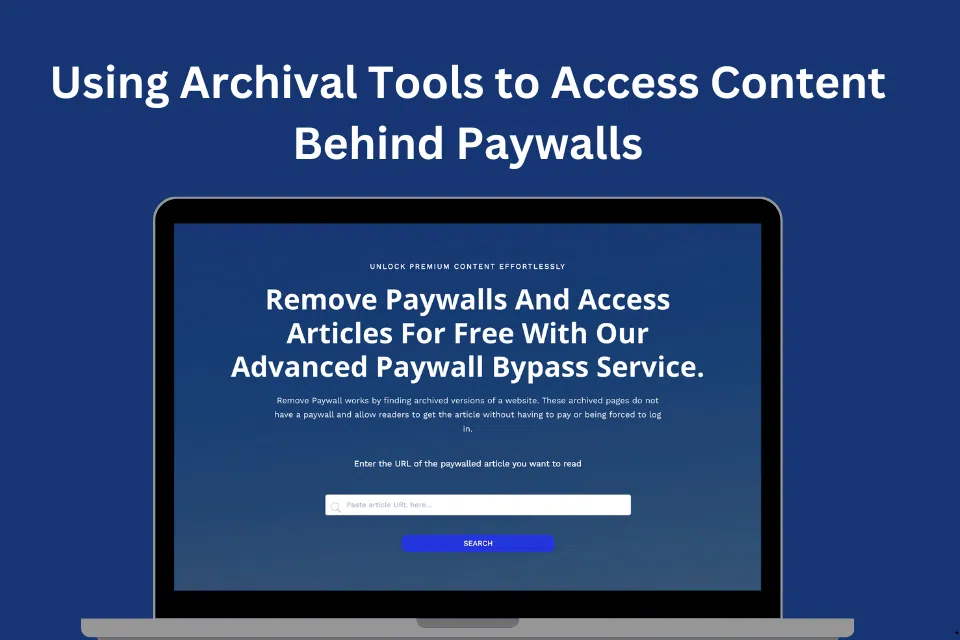In the digital age, accessing content has become both easier and more challenging. While information is readily available, paywalls often restrict access to valuable content. This article delves into how to use archival tools to bypass paywalls and access archived articles for free, ensuring that vital knowledge remains accessible to everyone.
How to Use Archive Sites to Access Content
Archive sites can be a valuable resource for accessing content that is otherwise behind a paywall. Here’s how you can effectively use these tools:
- Wayback Machine
The Wayback Machine is one of the most popular archival tools available. Operated by the Internet Archive, it allows users to see archived versions of web pages across time. Here’s how you can use it to bypass paywalls:
- Visit the Wayback Machine: Go to archive.org.
- Enter the URL: Copy the URL of the paywalled article and paste it into the Wayback Machine’s search bar.
- Browse Snapshots: The tool will show you different snapshots of the page taken at various times. Select a snapshot taken before the paywall was implemented.
- Access the Content: Click on the snapshot to view the archived version of the page, often free of the paywall restrictions.
- Google Cache
Google Cache stores copies of web pages as they were when Google’s web crawler last visited them. This can be particularly useful for bypassing paywalls:
- Search for the Article: Use Google to search for the title of the paywalled article.
- Access Cached Version: Next to the URL in the search results, click on the small green arrow or the three dots (depending on your device) and select “Cached.”
- View Cached Page: This will take you to the cached version of the page, which might be free from paywall restrictions.
- Library of Congress Web Archives
The Library of Congress also maintains an extensive web archive. While it’s more limited in scope compared to the Wayback Machine, it can be a useful resource for older or historically significant content:
- Visit the Archive: Go to loc.gov/websites.
- Search by Keyword or URL: Use the search functionality to find archived versions of the content you need.
- Access the Archive: Browse through the results to find and access archived versions of paywalled content.
How to Access Archived Articles for Free
Accessing archived articles for free can save you from the hassle of dealing with paywalls. Here are some effective methods:
- Utilize Open Access Journals
Open access journals are freely available to the public and can be an excellent resource for academic and research articles:
- Directory of Open Access Journals (DOAJ): Visit doaj.org to find thousands of peer-reviewed open access journals.
- Search for Articles: Use keywords related to your research to find relevant articles that are freely available.
- Repositories and Institutional Archives
Many universities and research institutions have their own digital repositories where they store and make accessible their publications:
- Institutional Repositories: Check if the university or research institution you are affiliated with has a repository. Often, you can access these for free.
- Public Repositories: Sites like PubMed Central for biomedical literature and arXiv for preprints in various fields are excellent resources for free articles.
- Public Libraries
Public libraries often provide access to a wide range of digital resources, including archived articles. Here’s how to leverage your library’s resources:
- Library Website: Visit your public library’s website and look for digital resources or databases.
- Library Card Access: Use your library card to log in and access various journals, newspapers, and magazines that are otherwise paywalled.
- Use Scholar-Specific Search Engines
Google Scholar and other academic search engines often link to free versions of articles:
- Google Scholar: Search for the article title in Google Scholar (scholar.google.com). Look for links to PDFs on the right side of the search results.
- Academia.edu and ResearchGate: These platforms often host articles uploaded by the authors themselves. You can request a copy directly from the author if it’s not freely available.
- Interlibrary Loan (ILL)
Interlibrary loan services can provide access to articles and books that your local library doesn’t have:
- Request an Article: Contact your library and request the article through their interlibrary loan service. Libraries often collaborate to share resources.
- Digital Copies: Many libraries provide digital copies of articles through ILL, making it convenient to access them from anywhere.
- Author Repositories and Personal Websites
Authors often upload their publications to personal websites or institutional repositories:
- Search for the Author: Look for the author’s professional webpage or profile on their institution’s website.
- Direct Requests: If you can’t find a freely available version, email the author and politely request a copy of the article.
Conclusion
Accessing content behind paywalls and archived articles for free is not only possible but can be done ethically and legally with the right tools and techniques. By leveraging archival tools like the Wayback Machine and Google Cache, and utilizing open access resources, institutional repositories, and public libraries, you can ensure that vital knowledge remains within your reach.
For more comprehensive strategies and tools to bypass paywalls and access restricted content, explore our detailed guide on Effective Strategies to Access Restricted Content. Supporting open access initiatives and ethical sharing of knowledge helps create a more informed and educated society, benefiting all.
By utilizing these methods, you can significantly enhance your ability to access the information you need, contributing to your research, learning, and overall knowledge.





